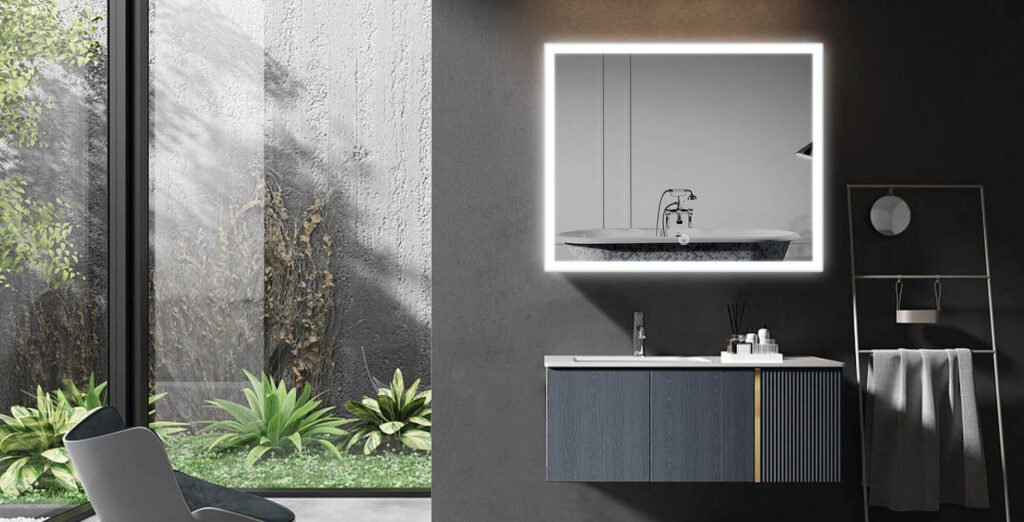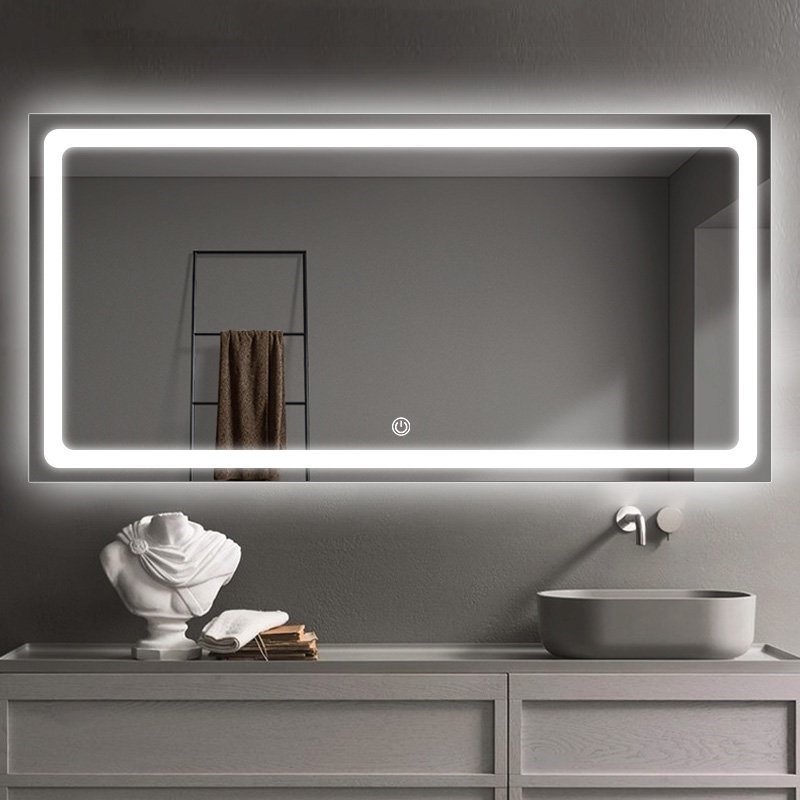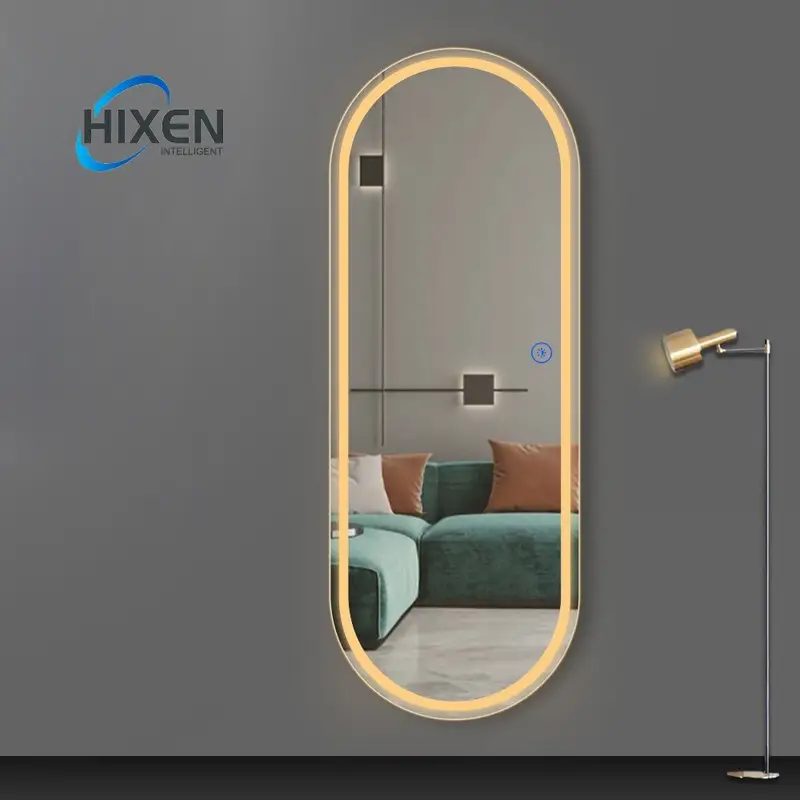|
Obtenir votre Trinity Audio joueur prêt ...
|
Miroir de vanité sont devenus une partie vitale des espaces de toilettage modernes, Pourtant, de nombreuses personnes sous-estiment encore leur importance ou comprennent mal leur objectif.. La sélection du mauvais miroir peut conduire à un mauvais éclairage, Résultats de toilettage inexacts, Et même la frustration. Donc, Qu'est-ce qu'un miroir de vanité, Et pourquoi est-ce essentiel?
Un miroir de vanité est un miroir spécialement conçu spécialement pour les tâches de toilettage telles que l'application de maquillage, rasage, ou routines de soins de la peau. Contrairement aux miroirs ordinaires, Les miroirs de vanité incluent souvent des fonctionnalités telles que l'éclairage LED, grossissement, et des angles réglables pour améliorer la clarté et la visibilité.
Les miroirs de vanité peuvent varier considérablement en conception, du miroir glamour de la vanité hollywoodienne utilisée par les maquilleurs pour compacter des options de voyage ou de petits espaces. Populaire parmi les propriétaires et les professionnels, Ces miroirs mélangent la fonctionnalité et l'esthétique, En faire un ajout pratique et élégant à n'importe quel espace.

Recherche menée par le Institut d'éclairage et d'ergonomie (2021) montre que l'utilisation d'un miroir avec un éclairage approprié, comme un miroir rétro-éclairé, Améliore considérablement la précision des routines de toilettage en réduisant les ombres et en améliorant la visibilité. Cela explique pourquoi beaucoup fabricants de miroirs de salle de bains se sont déplacés vers la production de miroirs de vanité éclairés qui simulent la lumière du jour naturelle.
Quel est le but d'un miroir de vanité?
Les miroirs de vanité ne sont pas seulement des miroirs ordinaires; Ce sont des outils spécialisés conçus pour améliorer les expériences de toilettage personnelles. Voici les principaux objectifs d'un miroir de vanité:
1. Visibilité améliorée
Un miroir de vanité, Surtout un avec un éclairage LED, assure un éclairage égal et brillant. Contrairement à l'éclairage standard, qui peut créer des ombres, Un miroir de vanité bien éclairé offre une lueur cohérente qui imite la lumière du jour naturelle. Cette clarté est cruciale pour les tâches comme l'application de fondations, maquillage de mélange, ou assurer une couverture cutanée uniforme. Par exemple, un miroir rétroéclairé minimise les ombres, offrant une vue claire de chaque angle.
2. Précision des tâches de toilettage
Les miroirs de vanité sont souvent équipés de caractéristiques d'agrandissement, comme le grossissement 3x ou 5x. Ceux-ci sont inestimables pour les tâches complexes comme les sourcils à pincer, Appliquer un eye-liner, ou inspecter les imperfections. Le grossissement garantit qu'aucun détail n'est manqué, permettant aux utilisateurs d'obtenir un look poli et précis.
3. Multifonctionnalité pour divers besoins
Les miroirs de vanité moderne offrent plusieurs fonctions au-delà de la simple réflexion. Des fonctionnalités comme la température de couleur réglable aident à reproduire différentes conditions d'éclairage, comme la lumière du jour, Éclairage intérieur chaud, ou la lumière blanche fraîche. Cette polyvalence est particulièrement utile pour les amateurs de maquillage qui ont besoin de voir comment leur maquillage apparaît dans différents environnements.
4. Attrait esthétique
Au-delà, Les miroirs de vanité ajoutent un élément de sophistication à n'importe quelle pièce. Des options comme Miroirs de vanité hollywoodienne créer un glamour, ambiance professionnelle, Bien que compact, Les conceptions élégantes s'adressent à une esthétique minimaliste. L'ajout d'un miroir de vanité peut instantanément élever la conception d'une salle de bain, chambre à coucher, ou dressing.
5. Amélioration de la confiance
Avoir un dédié, Le miroir de haute qualité pour le toilettage peut améliorer la confiance. Se voir clairement et dans la meilleure lumière garantit que votre apparence est polie et professionnelle, ce qui peut avoir un impact significatif sur l'estime de soi.
(Preuves à l'appui: Une étude publiée dans le Journal of Ergonomics (2020) ont constaté que les individus utilisant des miroirs de vanité bien éclairés pour les tâches de toilettage ont vécu un 32% Amélioration de la précision des tâches par rapport à celles utilisant des miroirs standard.)
Quelle est la différence entre un miroir de vanité et un miroir ordinaire?
Bien que les deux miroirs de vanité et les miroirs réguliers remplissent la fonction de base de la réflexion, Leurs différences résident dans leur conception, caractéristiques, et utilisations prévues. Voici une comparaison détaillée:
1. Éclairage
- Miroirs de vanité: Équipé d'un éclairage intégré, Utilisation souvent de la technologie LED économe en énergie. Cela fournit un éclairage uniforme pour les tâches de toilettage, Réduire les ombres et améliorer la visibilité.
- Miroirs réguliers: Dépendre entièrement de l'éclairage des chambres ambiantes, qui peut être incohérent et insuffisant pour des tâches détaillées.
Par exemple, un miroir de vanité éclairée permet aux utilisateurs d'ajuster la luminosité et la température de la couleur, imiter la lumière du jour naturelle, Alors qu'un miroir ordinaire ne peut pas.
2. Grossissement
- Miroirs de vanité: Offrez fréquemment des options de grossissement, comme 2x, 5x, ou même 10x zoom, Permettre aux utilisateurs de se concentrer sur des domaines spécifiques pour le toilettage détaillé.
- Miroirs réguliers: Manque de grossissement, Les rendre moins efficaces pour les tâches de précision comme l'application de maquillage ou la pincement.
3. Fonctionnalité
- Miroirs de vanité: Inclure des angles réglables, conceptions pivotantes, et fonctionnalités anti-buts. Certains modèles sont même livrés avec des fonctionnalités avancées comme les haut-parleurs Bluetooth ou les commandes tactiles.
- Miroirs réguliers: Sont principalement statiques, Offrir une réflexion de base sans aucune fonction supplémentaire.
4. Cas d'utilisation
- Miroirs de vanité: Idéal pour les tâches nécessitant une attention aux détails, comme l'application de maquillage, rasage, ou coiffure.
- Miroirs réguliers: Mieux adapté pour la réflexion générale ou la vérification de l'apparence générale, comme la coordination des tenues.
5. Portabilité
Versions compactes des miroirs de vanité, comme Miroirs compacts, sont conçus pour les voyages et la portabilité, tandis que les miroirs réguliers sont souvent volumineux et stationnaires.
(Preuves à l'appui: Une enquête sur les consommateurs par le Association des fabricants de miroirs (2022) a trouvé que 76% des utilisateurs préférés des miroirs de vanité pour des tâches de toilettage détaillées en raison de leurs fonctionnalités d'éclairage et de grossissement supérieures.)

Pourquoi les miroirs sont-ils appelés vanité?
Le terme «vanité» associée aux miroirs a ses racines dans l'histoire et la culture. Voici une exploration de son origine et de sa signification:
1. Connexion historique aux tables de vanité
Dans le passé, Les miroirs étaient une caractéristique centrale des tables de vanité, qui ont été utilisés pour le toilettage et l'embellissement personnels. Ces tables étaient considérées comme des articles luxueux, Souvent détenue par les riches et associés à l'auto-administration. Le terme «vanité» est devenu lié à ces pratiques, symbolisant l'acte de se préparer avec soin et attention à l'apparence.
2. Influence glamour et hollywood
Au début du 20e siècle, La montée de Hollywood a apporté Miroirs de vanité hollywoodienne en proéminence. Ces miroirs, orné d'ampoules, est devenu des symboles emblématiques du glamour et du luxe. L'association de ces miroirs avec les célébrités et leurs vestiaires a solidifié le lien entre les miroirs et le concept de “vanité.”
3. Interprétation culturelle de la vanité
Dans la littérature et l'art, Les miroirs ont souvent été utilisés comme symboles de la vanité, conscience de soi, ou introspection. L'acte de regarder dans un miroir pour évaluer son apparence est devenu une métaphore de l'auto-complaisance, Donner naissance au terme «miroir de vanité».
4. Perspective moderne
Aujourd'hui, tandis que le terme conserve sa connotation historique, il représente également les soins personnels et la présentation personnelle. Les miroirs de vanité ne sont plus exclusifs à l'élite; Ce sont des outils pratiques accessibles à toute personne qui valorise le toilettage et l'apparence.
(Preuves à l'appui: Les archives historiques des archives du design victorien soulignent que les miroirs de vanité ont gagné en popularité dans l'Europe du XVIIIe siècle dans le cadre des tables de pansement ornées utilisées par les aristocrates.)
N'importe quel miroir peut-il être utilisé comme miroir de vanité?
Alors que tout miroir peut techniquement refléter une image, Tous les miroirs ne conviennent pas aux tâches détaillées pour lesquelles un miroir de vanité est conçu. Voici pourquoi:
1. Carence en éclairage
Une caractéristique clé des miroirs de vanité est leur éclairage intégré, qui fournit même un éclairage essentiel pour des tâches comme l'application de maquillage. Les miroirs réguliers reposent sur un éclairage ambiant, ce qui peut créer des ombres et conduire à des résultats inégaux. Par exemple, un miroir rétroéclairé assure un éclairage optimal que les miroirs réguliers ne peuvent pas correspondre.
2. Manque de grossissement
Les miroirs de vanité incluent souvent des options de grossissement, Permettre aux utilisateurs de zoomer sur des zones spécifiques pour un toilettage précis. Les miroirs réguliers n'offrent pas cette fonctionnalité, Rendre des tâches comme l'application de l'eyeliner ou la pincement plus difficile.
3. Fonctionnalité et réglage
Les miroirs de vanité sont livrés avec des angles réglables et des fonctions pivotantes, les rendre polyvalents et ergonomiques. Miroirs réguliers, qui sont généralement fixes, manque de cette flexibilité, limiter leur convivialité pour le toilettage.
4. Conception et portabilité
Miroirs compacts et voyageurs Miroirs de vanité conduits sont légers et faciles à transporter, Contrairement aux miroirs ordinaires qui sont souvent volumineux et conçus pour un placement permanent.
5. Caractéristiques spécialisées
Les miroirs de vanité moderne incluent des fonctionnalités telles que la technologie anti-Fog, Connectivité Bluetooth, et commandes tactiles, aucun n'est disponible dans des miroirs standard.
Tandis qu'un miroir ordinaire peut être utilisé dans une pincée, Il n'a pas les caractéristiques spécialisées d'un miroir de vanité, le rendre moins efficace pour les tâches détaillées. Investir dans un miroir de vanité de qualité, surtout de la confiance Fabricants de miroirs LED, Assure une expérience de toilettage meilleure et plus efficace.
(Preuves à l'appui: Une étude de L'Institut Light and Vision (2021) a trouvé que 68% des participants ont obtenu de meilleurs résultats de maquillage lors de l'utilisation de miroirs de vanité par rapport aux miroirs ordinaires.)

Où est le meilleur endroit pour mettre un miroir de vanité?
Le placement est crucial pour maximiser la fonctionnalité d'un miroir de vanité. Considérez ces conseils:
- Lumière naturelle: Positionnez votre miroir près d'une fenêtre pour profiter de la lumière du jour.
- Éclairage LED: Pour les chambres sans lumière naturelle suffisante, Utilisez un miroir rétro-éclairé ou un miroir de vanité LED.
- Hauteur ergonomique: Le hauteur de miroir de vanité standard est à 60 à 65 pouces du sol au centre du miroir, Assurer une utilisation confortable.
En plus, Placer votre miroir dans une zone avec un minimum de distractions et une bonne ventilation améliore l'expérience de toilettage globale. Les designers d'intérieur recommandent de combiner des miroirs avec un éclairage intégré pour créer un espace bien éclairé et esthétique.
(Source: Home Design Magazine, 2022)
Quelle est la tendance actuelle dans les miroirs de salle de bain?
Les miroirs de salle de bain modernes sont une fusion de style et de technologie, avec des fonctionnalités qui s'adressent aux fonctionnalités et à l'esthétique:
- Caractéristiques intelligentes: Revêtements anti-buts, Haut-parleurs Bluetooth, et les commandes sensibles au toucher deviennent standard.
- Miroirs rétro-éclairés: Ces miroirs fournissent doux, Même l'illumination, Parfait pour les tâches de toilettage.
- Personnalisation: Beaucoup de dirigeants Fabricants de miroirs LED Offrez maintenant des miroirs qui peuvent être adaptés à des tailles spécifiques, formes, et les fonctionnalités.
Données du Rapport de marché de la maison intelligente (2023) révèle un 50% Augmentation de la demande de miroirs de salle de bain personnalisables, Poussé par les propriétaires à la recherche de solutions personnalisées.
Comment les miroirs de vanité sont-ils attachés au mur?
L'installation d'un miroir de vanité nécessite une planification et des outils appropriés. La plupart des miroirs muraux sont livrés avec des supports ou des supports adhésifs pour une installation sécurisée.
Pour les miroirs plus lourds, comme les miroirs de vanité hollywoodiens, Des accessoires renforcés et une installation professionnelle sont recommandés. Miroirs de vanité conduits Viennent souvent avec des guides détaillés pour assurer un montage sûr et sans tracas. Assurer toujours les composants électriques, comme l'éclairage, sont installés loin des zones sujettes à l'humidité.
(Source: Guide d'installation de bricolage, 2022)
Quelle forme devrait être un miroir de vanité?
La forme d'un miroir de vanité affecte à la fois sa fonctionnalité et son attrait esthétique:
- Miroirs ronds: Créer un doux, look élégant et sont idéaux pour les petits espaces.
- Miroirs rectangulaires: Fournir une réflexion plus large, Convient aux salles de bains partagées ou plus grandes.
- Miroirs ovales: Offrez un mélange de styles contemporains et classiques.
Experts de haut fabricants de miroirs de salle de bains Suggérez de sélectionner une forme qui complète le décor de la pièce tout en s'alignant avec vos besoins de toilettage personnels.
(Source: Tendances de décoration intérieure, 2023)

Quelle est l'histoire du miroir de vanité?
Les miroirs de vanité ont une histoire riche qui s'étend sur des siècles:
- Origines anciennes: Les premiers miroirs ont été fabriqués à partir de métaux polis et utilisés par les classes d'élite.
- Révolution industrielle: L'invention des miroirs en verre argenté au 19e siècle a révolutionné des outils de toilettage.
- Ère moderne: Les miroirs de vanité LED d'aujourd'hui combinent l'esthétique traditionnelle avec la technologie avancée.
L'évolution des miroirs de vanité reflète les attitudes sociales changeantes envers la beauté, soins auto-administrés, et l'innovation.
(Source: Archives de l'histoire du miroir, 2020)
Quel est le but d'un miroir dans une salle de bain?
Un miroir de salle de bain sert plusieurs fonctions:
- Toilettage: Du rasage à la coiffure, Les miroirs sont des outils essentiels pour les soins personnels.
- Esthétique: Un miroir bien placé peut améliorer le sens de l'espace et de la lumière dans une salle de bain.
- Innovation: Des caractéristiques comme les revêtements anti-buas et l'éclairage réglable rendent les miroirs modernes hautement fonctionnels.
Investir dans un miroir de salle de bain de haute qualité assure la durabilité et la praticité, Même dans des environnements humides.
(Source: Home Improvement Journal, 2022)

Conclusion
Les miroirs de vanité sont des outils essentiels qui élèvent l'expérience de toilettage en fournissant un éclairage amélioré, grossissement, et conception ergonomique. Que vous choisissiez un miroir rétroéclairé, Un miroir de vanité hollywoodienne, ou un produit personnalisé d'un usine miroir LED, Le miroir droit peut faire une différence. En considérant vos besoins et vos préférences, Vous pouvez trouver un miroir qui combine des fonctionnalités et de l'élégance pour s'adapter parfaitement à votre espace. Contactez-nous , Si vous voulez en savoir plus sur Vanity Mirror ~

























